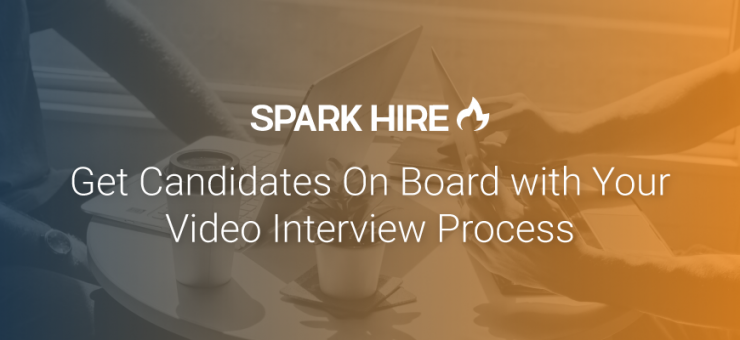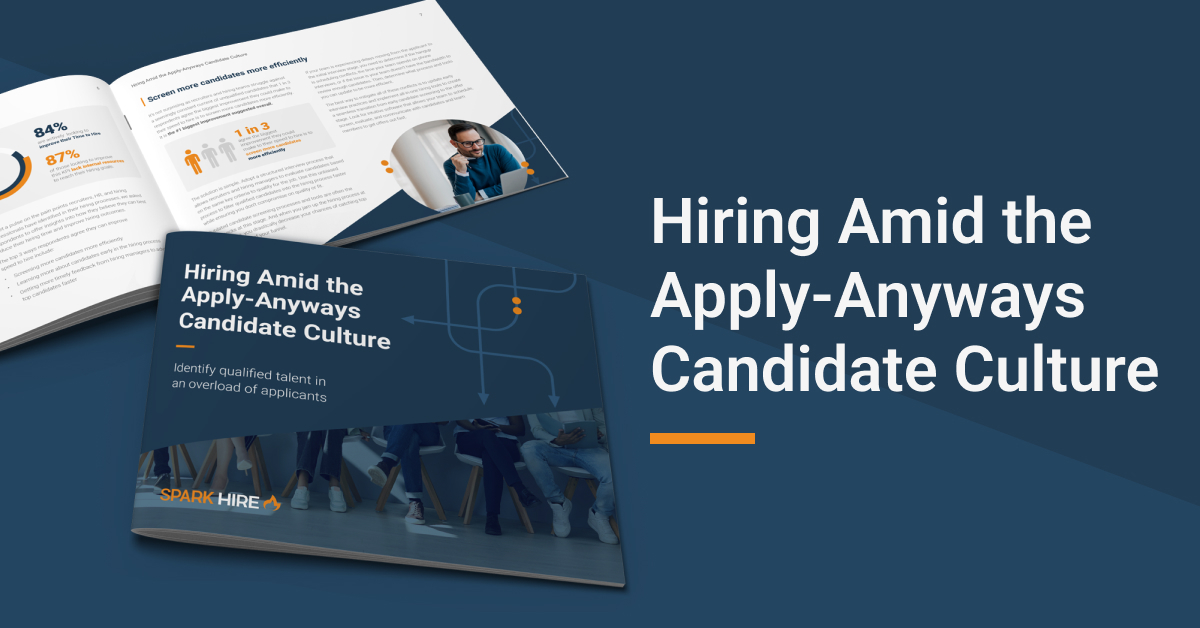If your hiring team wasn’t reaping the benefits of a structured video interview process prior to 2020, you probably made a quick shift. Most likely, you’re here because you now recognize the benefits of streamlining the hiring process and improving the candidate experience by making video interviews a permanent part of your talent acquisition toolbox. You also realize how important it is to have everyone on board.
Fortunately, you can train your team to effectively use a video interview platform. You’ve found plenty of resources and tips to transition your hiring staff. But getting your team on board with video interviews is only half of the equation. Candidates are the other half you need to consider.
You come across talent from all walks of life and in different stages of their careers. Most candidates use video technology to communicate with family and friends. But facing a camera for an interview may still feel unnatural. It could feel as though they cannot make a personal connection. And it’s difficult for some people to believe they’ve been fairly assessed for a position without facing their interviewer.
You know video interviews provide a convenient way for candidates to connect and prove themselves without the pressure of stressful commutes or complicated scheduling. You also know you can offer them the fairest and most consistent assessment by collaborating with your team over the same interview. But you need to convince the talent.
Here are our tips to get top talent on board with video interviews so everyone feels comfortable and confident during the hiring process:
Introduce the idea early
Don’t spring video interviews on candidates. Be transparent about the process in your job description and on your company’s career page.
Candidates look for clues about your work culture before applying, but they also research your interview process. Candidates can find example interview questions on sites like Glassdoor, and you better believe they are pulling as much information from their network as possible. The problem is, they might get the wrong idea if exact details about your interview process are not coming directly from the source.
Instead of keeping video interviews a mystery, include this information in the job description along with your instructions for applying. You can also shed light on your video interview process on your website. And it doesn’t hurt to mention it in other places you post open jobs, such as your social media profiles.
Create helpful guides
Many candidates have experience with video interviews but don’t assume everyone does. Right now — and in the future — you may encounter applicants who have never interviewed virtually.
In the same way talent researches your interview process, they will investigate the best approach to your video interviews. The catch is, your process is unique. It has to be to find the talent that fits your team dynamics. You don’t want top contenders for your open roles to miss the mark because they are inadequately prepared for your video interviews.
Crafting a basic video interview guide that outlines your process sets candidates up for success. It also ensures your hiring team makes the best use of their time interviewing talent. This guide should include a few common tips such as lighting, sound, and if you have preferred interview space requirements.
For example, it may be distracting if a candidate chooses to interview outside or in a cafe. Rather than disqualifying candidates who try to be creative or choose these locations because they feel comfortable in them, be forthcoming with your expectations. You may also want to let candidates know if they can re-record responses, who to contact if there are technical issues, and how long they can expect to wait for a response.
One of the great benefits of using a dedicated video interview platform: If there are issues with connections or candidates have questions about setting up before their interview, a support team member can help keep things moving along. Be sure candidates have a direct line of communication with someone on your team as well so they feel confident you want them to be successful with their video interview.
Send personal video messages
Email is likely going to be the first way you communicate after reviewing an applicant’s details. There’s no reason you can’t make this initial contact personal. Video messages get you in front of candidates and demonstrate how easy it is to connect through video.
The trick is making sure candidates recognize your authenticity and feel your message truly has been customized for them. There are many times it’s appropriate to create and send a canned video message to share standard information with candidates. But your welcome message should be custom for each candidate. After all, it takes less time to create than drafting a lengthy email introduction.
Write yourself a quick script you can follow until you get the hang of recording your custom video messages. Soon enough, it will become second nature. Candidates who see your face and hear your voice are more likely to let down their guard when using video interviews in your early screening process. They recognize a real person will receive and review their responses.
Don’t hesitate to add a bit of humor to break the ice and give candidates a real sense of who you are as a professional and a person. Your authenticity will calm their fears about being able to make a real connection without the customary handshake.
It’s a good idea to have other leaders or members of the team record brief video profiles. You can share these through a link in your welcome email, on the company site, or both. The more channels you can open for candidates to feel comfortable with video in your hiring process, the better.
Invite candidates to submit a one-way video
The one-way video interview is best used in the early screening process. There are several reasons one-way video interviews streamline initial assessments for everyone. Ultimately, you want candidates to see and feel the benefits right away.
By the time you invite candidates to submit their one-way video interview, you should have already welcomed them through video. Thanks to that experience, they’ll recognize that using video saves the viewer a good chunk of time and makes it easier to digest details. In fact, it’s been widely believed since studied in the 1980s that as much as 65% of people best retain information received through visual learning.
Once candidates realize they are free to record where and when it’s most convenient for their schedule, they’ll feel less stress at the onset of the process. Not having to coordinate multiple in-person interviews relieves a lot of pressure. And keep in mind, candidates desire a quick turnaround in the hiring process. Providing them a timeline of when they will hear back from you is the next step in securing their buy-in to your video interview process.
Vice versa, your team can review one-way video interviews where and when it’s most convenient for them. Their schedules are freed up from unnecessary in-person meetings in the early stages of the interview process. This means they have more room in their schedule to communicate with candidates and move top talent through to a final decision.
Follow up with next steps and feedback
Whether you choose to advance a candidate is not a reason to withhold valuable feedback about how they performed in their video interviews. Learning from the experience not only ensures talent comes away from your hiring process satisfied but also (and more importantly) improved. This is significant when you consider your company’s future hiring needs.
Ultimately, if video interviews prove intimidating or challenging for a candidate, any support and assistance you offer in improving their performance will leave a lasting impression. Naturally, you want new hires to feel confident you’re invested in their development. You should want candidates who funnel through your hiring process to believe the same. You never know when these talented professionals will grow into new open positions, even if they were not the right fit this time.
The experience candidates take away from your hiring process has an impact on your brand image. Creating a positive impression on candidates is invaluable. It ensures the top talent who funnel into your talent pool are confident and comfortable when entering your hiring process.
To provide the most effective and consistent feedback, your team could discuss specific points to review with all candidates regardless of if they move on in the process. For the talent you pass on, be sure to let them know if their video interview left an impression worth adding to your video library. Invite them to apply for future positions. These silver-medal candidates will likely be enthusiastic about submitting video interviews again.
Invite candidates to join a live video interview
Candidates rightfully expect an in-person interaction. They want to “show their stuff” and get a feel for the environment and leadership before accepting an offer. Even if your open role is in an office setting, however, your next logical step may be a live video interview.
It’s the next best thing to a handshake. Everyone gets to be present in real time, but real-life pressure isn’t applied in the same manner.
Candidates should be aware this is just their next step. You’re eager to get face-to-face before you bring them down to the office. When you reach out to invite talent to schedule their live video interview, make sure to explain any changes you expect from their one-way video submission.
For example, approximately how long should they ensure they have a quiet space? How many people will participate in the interview? Is there anything they should prepare such as a presentation? You can even offer them a few specific questions to consider ahead of the interview.
Use an interview scheduling tool to help everyone align schedules quickly and easily. By giving candidates a link to your calendar and inviting them to put themselves in for a video interview, you hand over some control to them. The ability to set a date and time is empowering for candidates. They get to pick when they’ll feel the most prepared and comfortable.
Any way you can boost their confidence ensures you see the most potential in the talent you interview, so everyone wins!
Follow up with feedback…again
Yes, this is necessary to mention a second time. It is a critical step in gaining confidence and buy-in to video interviews from candidates. There is a chance the live video interview is the last leg of the run for most of the candidates you interview. Not everyone can move on to the in-person interview stage. If candidates feel cut off before making an in-person connection, they are likely to blame your video interview process.
Don’t dismiss candidates who are upset they were not granted the opportunity to meet you face-to-face. Stay in contact and share constructive feedback from your team about the live video interview. This can help candidates determine how to improve for next time.












